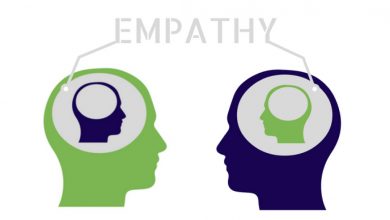Are you really listening?
How do we know whether or not we are “really listening”? If we realize that we are not “really listening”, and yet it’s in a situation where we should, how can we make ourselves listen? This article aims to be a support in the process of recognizing what kind of listening is taking place, and how to transition to “really listen” when we choose to do so.

Why did I choose this tool? I chose this tool because it gives some clarity on what can be a bit of a fuzzy topic – listening. It makes points that are easy to understand and makes it a bit easier to look inside yourself and others. Awareness is power, so merely the awareness can help us change our listening habits, if we choose to do so.
How does this apply to being a trainer? Particularly when starting out it’s common to think that being a great trainer is all about speaking and sharing information effectively. While this can make an excellent public speaker, being a great trainer also includes the ability to really listen to the participants and understand what they want to say and how they feel. For me personally this can be the hardest part, as it requires being continually present, focused and really caring about the participants, more than what I want to say. Like any other skill, really listening (or “listening to understand” as described in this article) is something that can be improved with continual practice, to the point where it becomes second nature.
Main content:
In his book “Understanding Yourself & Others” Bob Thomson states that there are actually 4 different levels of listening.

Not listening – If you’ve ever tried to talk to someone while they were engaged in something else, and perhaps they were saying “uh huh” at random intervals, but not really engaging in anything you were saying, then you have experienced firsthand the “not listening” level.
Listening, waiting to speak – This is when you are listening but, in the meantime, you’re reviewing in your head what you are going to say or waiting anxiously for a chance to say your piece. You may politely wait for the person to pause so you can jump in, or you may interrupt them while they are still speaking. In either case, you are “listening waiting to speak”.
Listening to disagree – This kind of listening happens in arguments when someone wants to prove that they are right or in debates where the main goal is to get your point across so that you can “win” and the other person can “lose”. You are looking for flaws in what the other person is saying, and you are reviewing in your head how you can prove yourself right.
Listening to understand – This kind of listening happens when you are fully present with the other person, don’t allow yourself to be distracted with anything else in your head or in your environment, and you have no other agenda rather than to really understand what the other person is trying to express. Here, you consider not only what that they are saying, but how they are saying it, the gestures they are using and most importantly the emotions that they are portraying.
Although, the other types of listening certainly have their time and place, the type of listening that we are referring to in this article, the type that has the potential to transform your reality and to create a genuine connection between two people is “listening to understand”.
So how do we know whether or not we are listening to understand, and if we realize that we are not generally listening to understand, how can we change that?
Listening to understand can include all the following elements, but isn’t possible without at least the first one.
- Empathizing – you need to actually care about what the other person is expressing, and be empathetic towards them. If you don’t feel that you are in a state where you can do this, if you feel stressed or angry or anxious, then rather than pretend to care or listen, it is better to postpone the conversation for a time when you can fully be present with them and be capable of empathizing with them. When you fake it, and someone is expressing something that is deeply important to them, they can easily pick up on that and it can actually have worse results than if you haven’t had that conversation in the first place.
- Playing back – to show that you’re really listening, and also to double check if you actually understand what they are trying to say, you can summarize what you heard and reflect back their words to them. It’s important if you do this, to be open to the fact that you may have misunderstood something and to not let yourself be offended if the person says something like “no that’s not what I meant at all” or “you misunderstood me”. Remind yourself that you are ‘listening to understand’, not only wanting ‘to be right’, and invite them to clarify anything that you may have misunderstood.
When playing back, it’s also important to do it in a way that feels natural and not like you’re just “going through the motions”. The following paragraph helps to put it into perspective, and perhaps to understand when it will be helpful to use playing back, and when it won’t. For instance, it might be useful to summarize important points that someone said in a training setting to show that you heard and understood them, whereas it might backfire if your girlfriend comes home and says “I’m really angry at my boss” and you play back to her “I hear you saying that you’re really angry at your boss”.
“My problem with playing back, reflective listening and other allegedly empathy-raising techniques is that they’re very obvious techniques, and I could see through them even as a toddler. I still can, though I have more patience today than I did then. I realize that people who use mirroring are trying very hard to get into sync with me, and I have empathy for that. But when I talk to you, and especially when I talk to you about trouble, I don’t want you to rephrase what I said. I know what I said, and I know how I feel. I’m talking to you because I want support or input or help or humor or love or commiseration or a crankfest or a complaining partner. If I’m talking to you when I’m in trouble, it means that I already trust you and believe in you. I already know that you can hear me. You don’t need to parrot me to empathize with me. You need to interact—honestly, authentically, and as yourself. When I talk to you, I don’t want to talk to a mirror; I don’t want to see myself. I want to see you.”
McLaren, Karla. The Art of Empathy: A Complete Guide to Life’s Most Essential Skill Sounds True. Kindle Edition.
- Questioning – this is where you invite the person to express more comprehensively their thoughts and their feelings. Questioning in this context is powerful because in expressing themselves to you they can actually become even more clear about their own thoughts and feelings on the matter. Questioning in this context is so powerful that there are entire healing professions based on asking the right questions (ex: psychotherapy and coaching). Asking the right questions as a trainer can greatly enhance your performance and your connection with the participants. To accomplish this purpose the questions should be open rather then closed. For example, instead of asking “did you like the training”, which would bring only a yes or no response, it is more effective to ask “how do you feel about the training”? When you get an answer like “I feel good about it” you can help them to express even more by saying “what aspects of the training do you feel good about, can you give some examples?” It’s important that your demeanor, tone of voice and body language show that you are relaxed, open and interested in what they have to say. Otherwise you might be asking very open questions, but at the same time giving the feeling that you are not open to them at all, which can create confusion and cause them to shut down.
The main barrier to “listening to understand” is not being present in the moment. Not being present can happen for a variety of reasons. It could be that we are preoccupied with something else, that we are rehearsing what we want to say next, that we are not feeling confident and calm, or merely because there are other thoughts in our head preventing us from being able to “listen to understand”. Presence is powerful, and in itself it can be the “make or break” of a training.
The opposite of not being present in the moment (and with the person who is speaking) is what I call “being in your head”. When you are in your head, you’re not with the person who is speaking (or with the participants in a training). It’s as simple and as difficult as that, and it can be felt by the other person (or people), whether consciously or subconsciously.
If you find that you are “in your head” more then you would like to be, here are some steps you can take to get back into the moment and with the participants (or whoever you are with at that moment).
- If you are worried about something, make a decision about when you will deal with it so that your mind can stop mulling over it. Then get back to the present.
- If you are concerned about yourself (how you are coming across, what people are thinking about you, whether you are “good enough”) change your focus instead to the question “how can I best contribute to the participants at this moment”? This will shift your perspective from yourself and what’s going on in your own head, towards the participants and their needs, and will put you in a better position to listen and be present with them.
- If it’s tiredness that’s making it hard to focus and listen, then take a break and get back to the session with a fresh mind, or perhaps end the day a bit early. Going on after you (and/or the participants) are too tired to listen is unlikely to bring a positive outcome. If you are taking a break, try to go outside for a few breaths and even to do a bit of physical movement. Getting in touch with your body is a great way to come back to the present.
- If you are not worried, concerned about yourself, or tired, then ask yourself: What is preventing me from being in the moment? It may be something you don’t expect, maybe you don’t like a participant very much and so your mind shuts down whenever they speak. Or maybe you’re not very interested in the topic and that’s what’s causing you to tune out. In any case you aren’t doing anyone (including yourself) a favor by pretending to be present when you are really not.
It might sound difficult to “listen to understand” and “be present in the moment”. However, when you become practiced at it and you are doing it regularly, whether as a trainer or in your everyday life, the results can be life changing and well worth the effort. It doesn’t mean you have to be 100% present and focused on things you don’t want to be present or focused on. Rather it means that wherever you decide to be and whatever you decide to engage in, you do it with body, mind and heart.
Reflection questions:
What percentage of the time I spent listening to others and am I “listening to understand”?
Am I happy with this percentage?
What kind of listening am I doing the rest of the time?
Do I make sure that people feel listened to and understood when they are talking to me?
If not, what steps can I take to improve on this?
When I am giving a training or talking to someone one on one, am I fully present in the moment most of the time?
If not, what steps can I take to improve on this?
How will this improve the quality of my trainings, the quality of my relationships, and the overall quality of my life?
Exercises:
How to apply it in everyday life:
Practicing meditation regularly is a good way to learn how to harness the mind and be present in the moment with yourself and your feelings. When you are present with yourself and your feelings, and you have your mind under control, then you are capable of doing this with others as well.
In the moments when you find your mind wandering, and you find yourself not being present in the moment, decide on some subtle way to bring yourself back (taking a deep breath, snapping your fingers, telling yourself mentally to “come back and be present”, etc.) Keep doing it and don’t give up, until you find that your default mode is “present and listening”.





